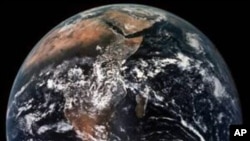The first direct evidence of what the atmosphere was like shortly after the Earth formed 4.5 billion years ago is challenging the prevailing theory that life on the young planet developed in a hot, oxygen-poor stew of toxic gases.
Researchers at the Rensselaer Polytechnic Institute in New York say their analysis of some of the planet’s oldest minerals indicate that atmospheric conditions on Earth just 500 million years after it coalesced from stellar dust and gas were surprisingly like conditions today.
The scientists say their research proves that conditions four billion years ago were conducive to production of the same oxygen-rich compounds currently in the atmosphere, including water, carbon dioxide, and sulfur dioxide.
Their tests on minerals found in magma - the molten rock beneath the Earth’s surface that volcanoes eject as lava - allowed the scientists to identify gases that would have released into the new planet's atmosphere during an era of frequent volcanic activity.
The new findings have implications for understanding how life evolved on the infant Earth, and how life could begin as well on other planets in the universe. The results also lend credence to theories that the basic elements of life did not originate on Earth, but were delivered here by meteorites and comet strikes.
The Rensselaer study, which was funded by the U.S. space agency, NASA, is published in the journal, Nature.
Scientists Say Young Earth's Atmosphere Much Like Today's








